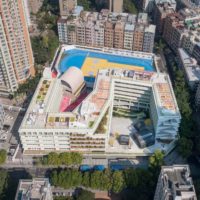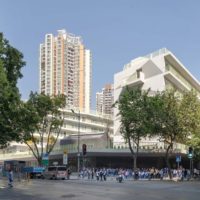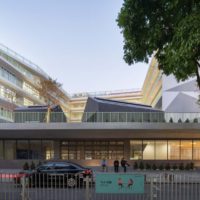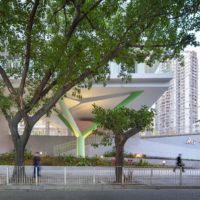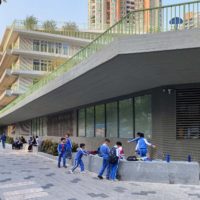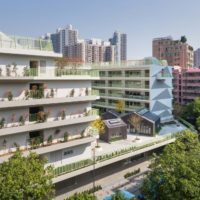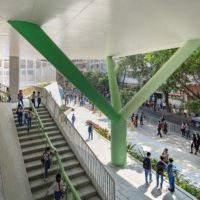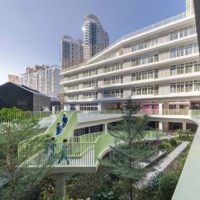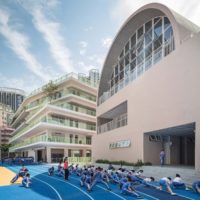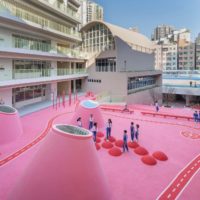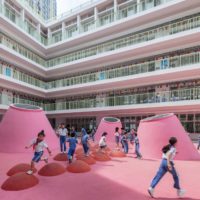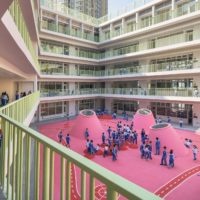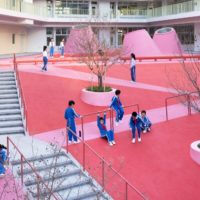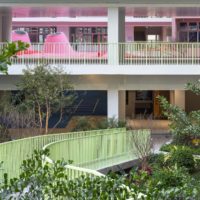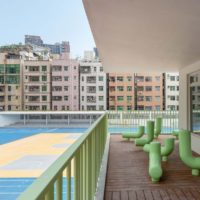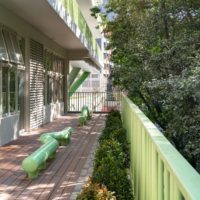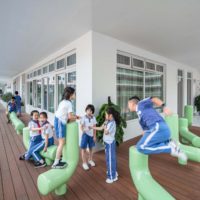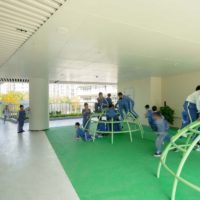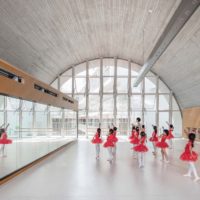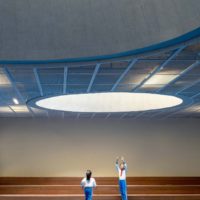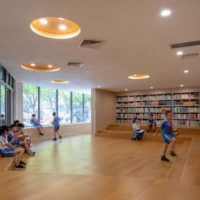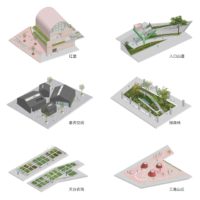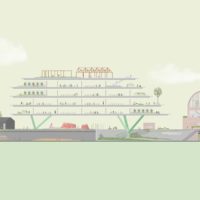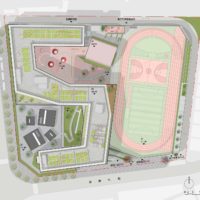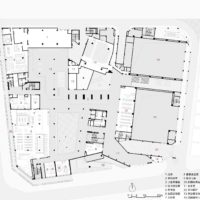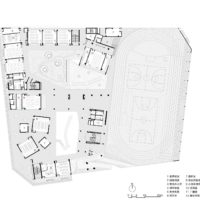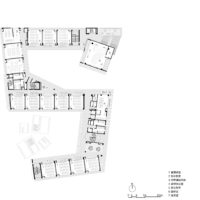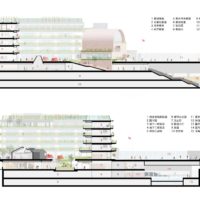Xinsha Primary School is a part of the “8+1 Futian New Campus Action Plan” initiated by the Shenzhen Municipal Planning Bureau, trying to explore a new type of Primary school campus under the high-density requirement. The campus occupies an area of 11,000 square meters. A new school building with a total construction area of about 37,000 square meters was designed on the demolished old school site, accommodating 36 classes and 5 reserved classrooms.
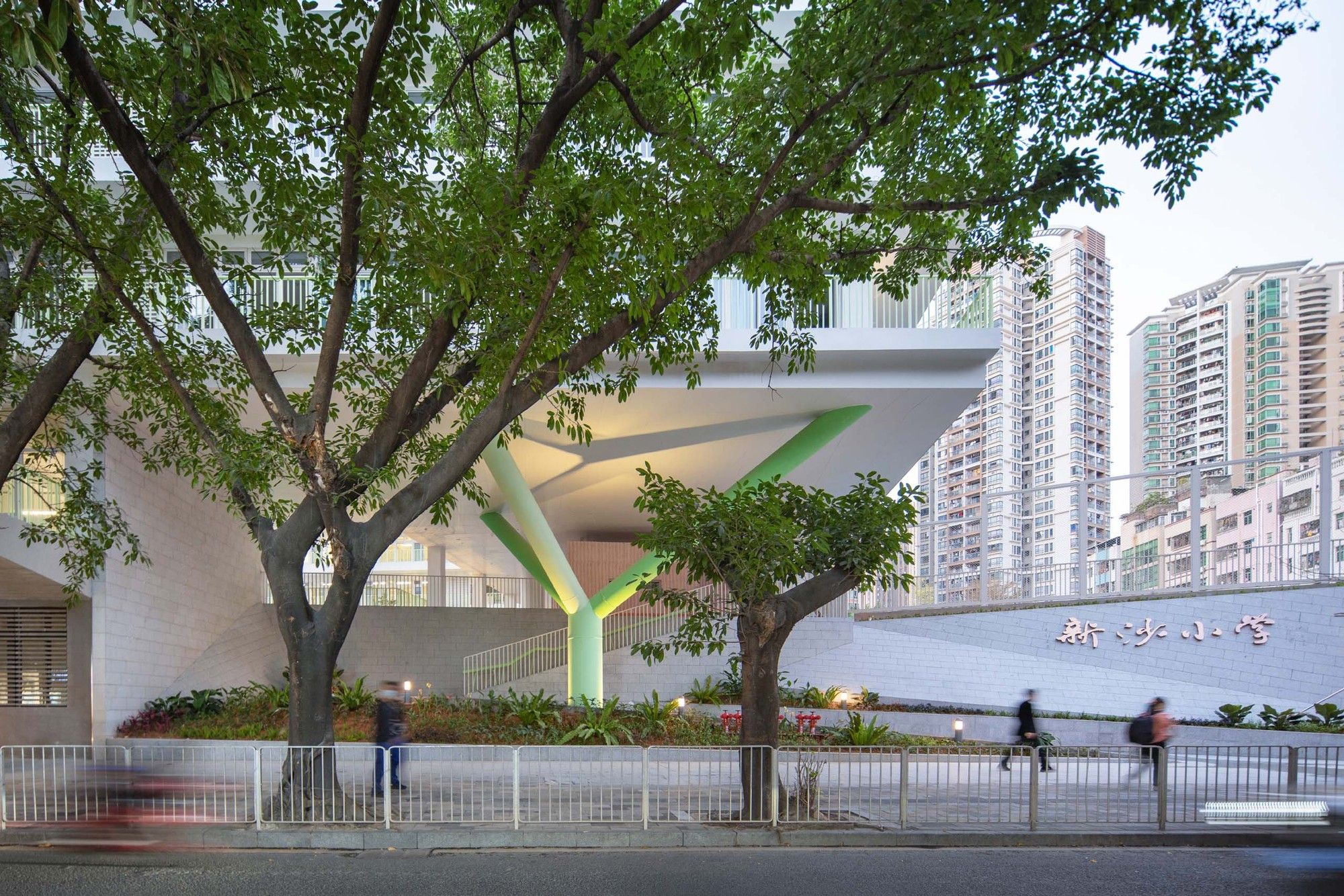
The main entrance to the campus. Image © Chao Zhang
To rebuild the harmonious relationship between the campus and the neighborhood, we decided to avoid using fences and designed an arcade instead. In our imagination, the picture of the ideal school is that children are running and playing all over the campus with vigorous and smiling faces. Therefore, the main entrance design as its representation presents a natural and soft atmosphere like a park landscaped entrance.
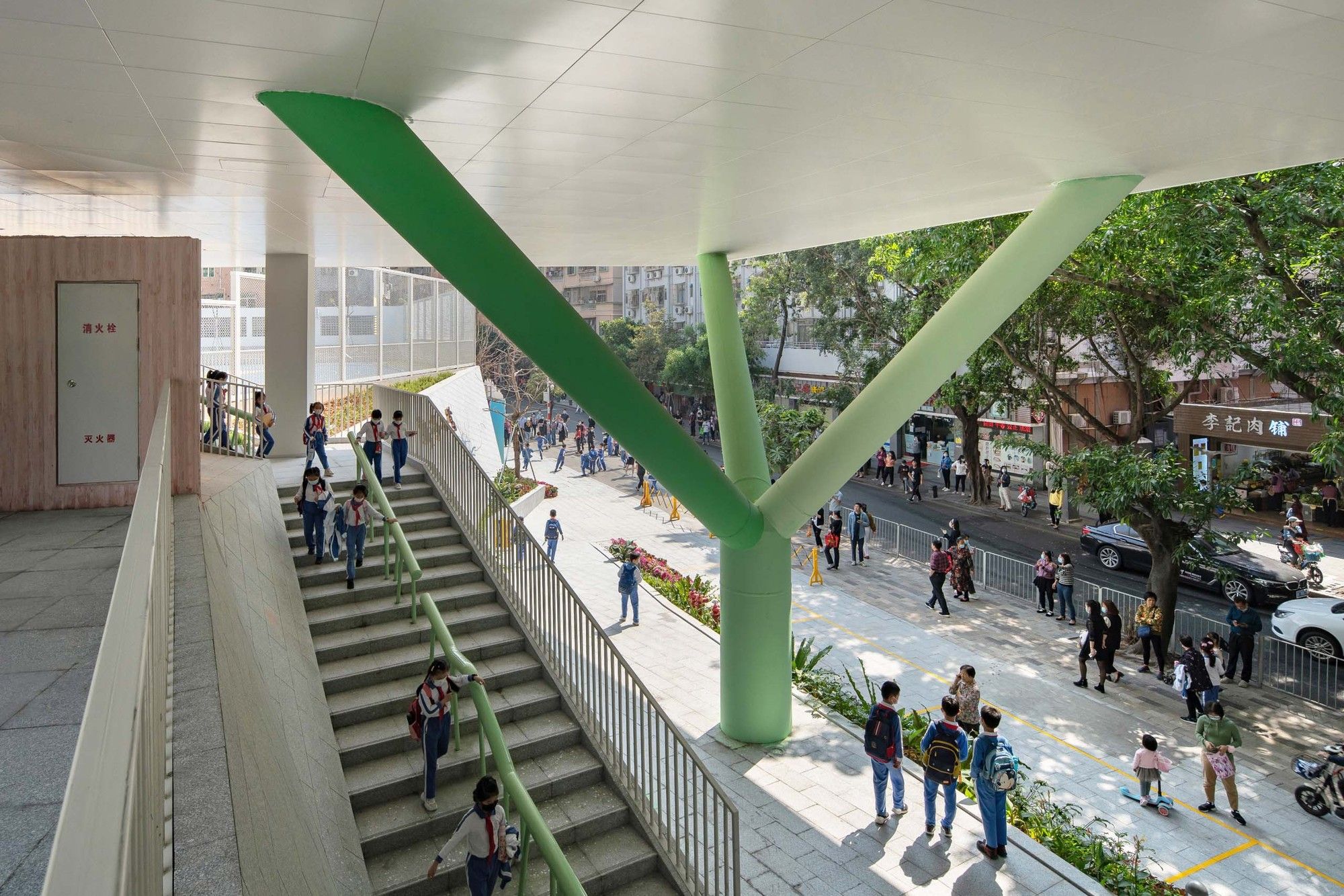
The unique shaped-column at the entrance. Image © Chao Zhang
The benches arranged along the arcade provide a resting space for students’ parents and community residents with the shade and a shelter from the rain. Looking up, you can see students playing on the platform and hear their romp. There are lush roadside trees more than 10m high along the street. And, to echo this wild streetscape, the ceiling of the arcade is made of wood-textured concrete, and the walls are made of rough-textured terracotta tiles.
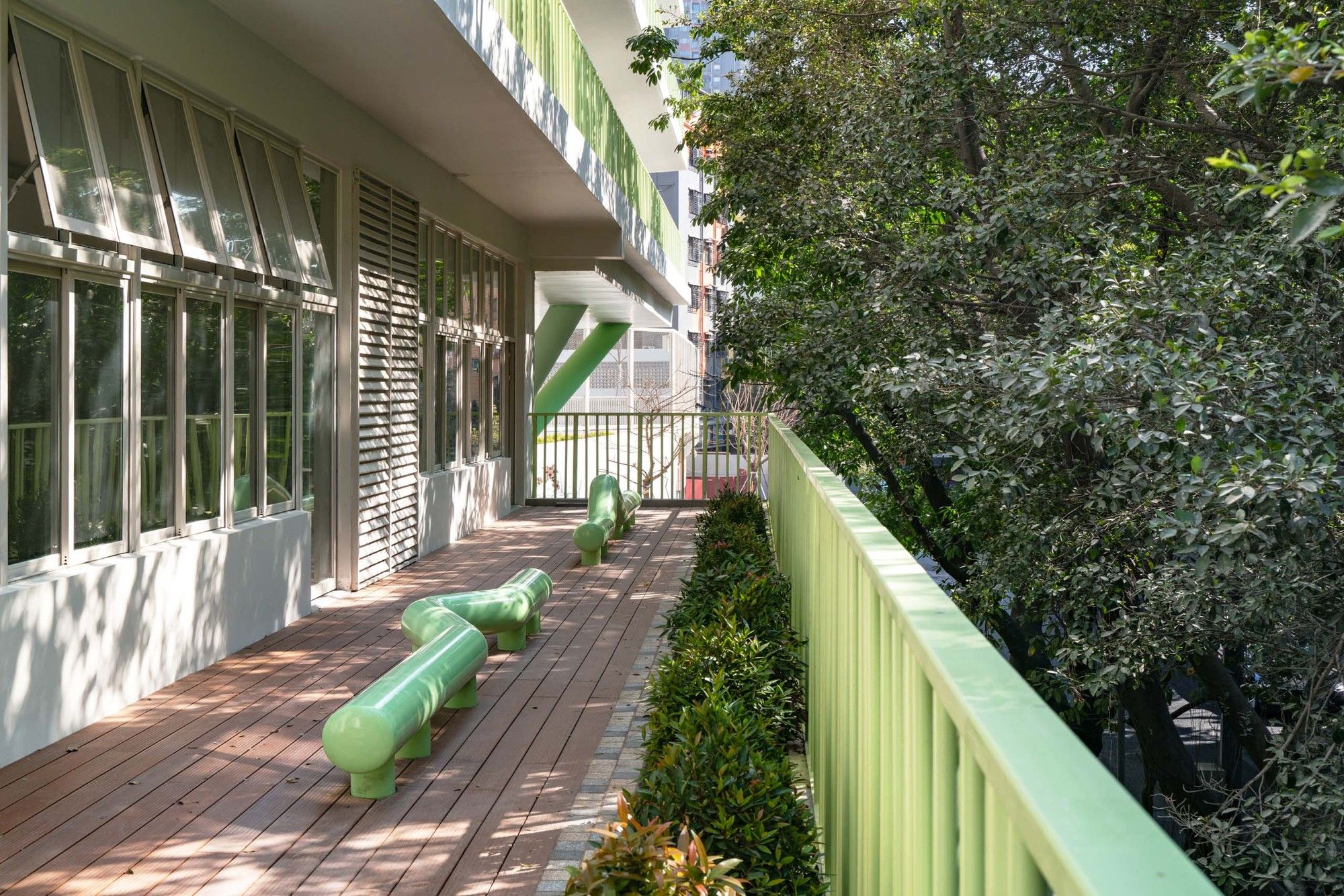
Landscape installation on the platform. Image © Chao Zhang
We tried to replace the role of the fence wall with the height difference between the streets and the campus, covering the entire site with a podium and elevating the main activity ground up on the second floor. Through the S-shaped layout, the teaching building encloses the north and south courtyards, the north courtyard opens towards the large playground of the school, and the south courtyard opens towards the city crossroads. The teachers and students walking through the teaching building can alternately see the scenery inside and outside the school, and experience the sense of locality of the school and the community they are in.
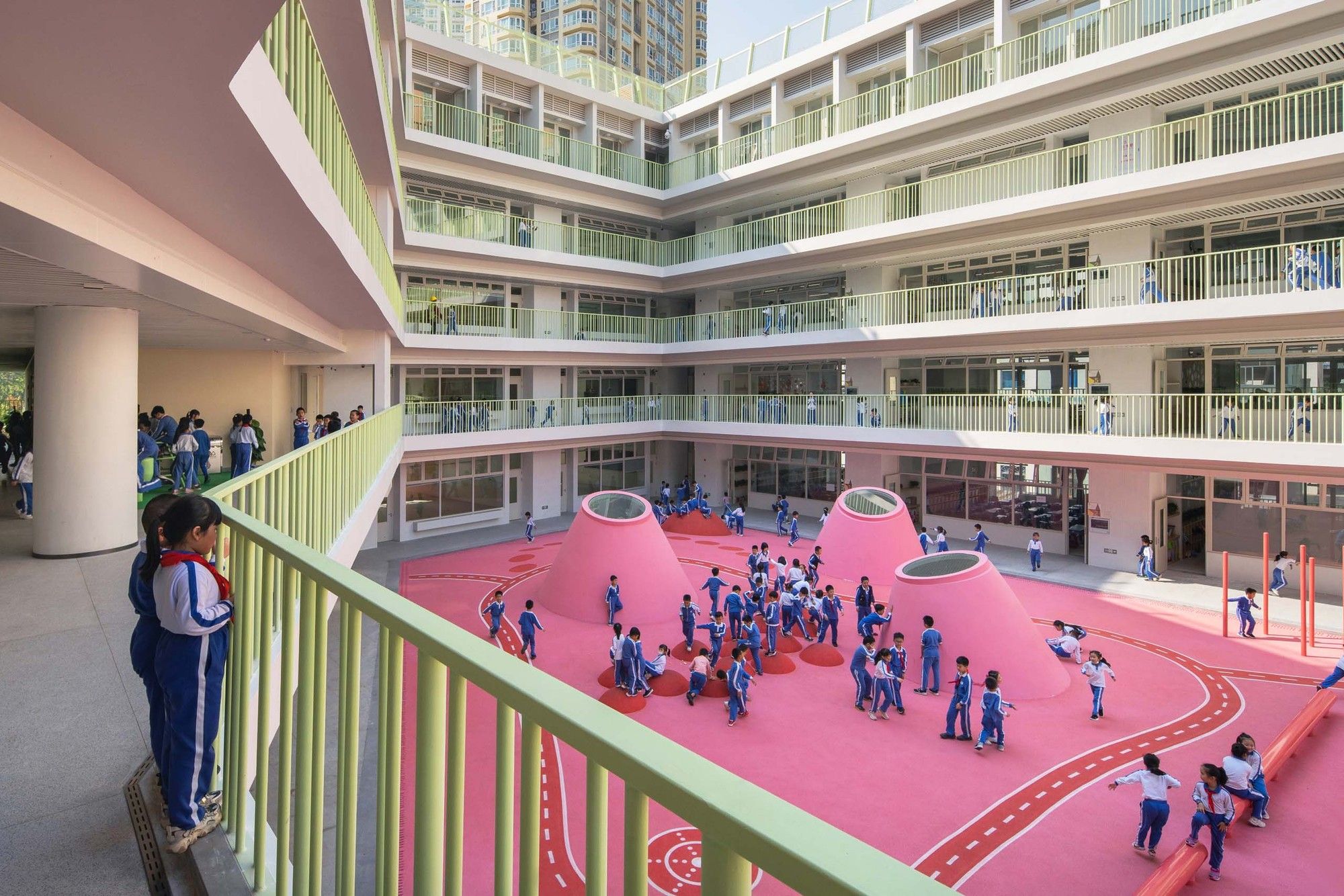
Guardrail design. Image © Chao Zhang
The library and restaurant arranged along the street on the first floor of the arcade are separated from the outside by just a wall. We developed two designs of the wall to deal with the sensitive edge of the campus: one is a large fixed glass that ensures lighting and sight; the other is the louver made of horizontal terracotta bars and operable glass windows inside that ensure natural ventilation with safety.
The arcade space is within the site boundary and is owned by the school. Through its community sharing to improve the urban space, the school was granted special approval by the Planning Bureau of “less building step-back”, gaining a large platform at the second-floor level.
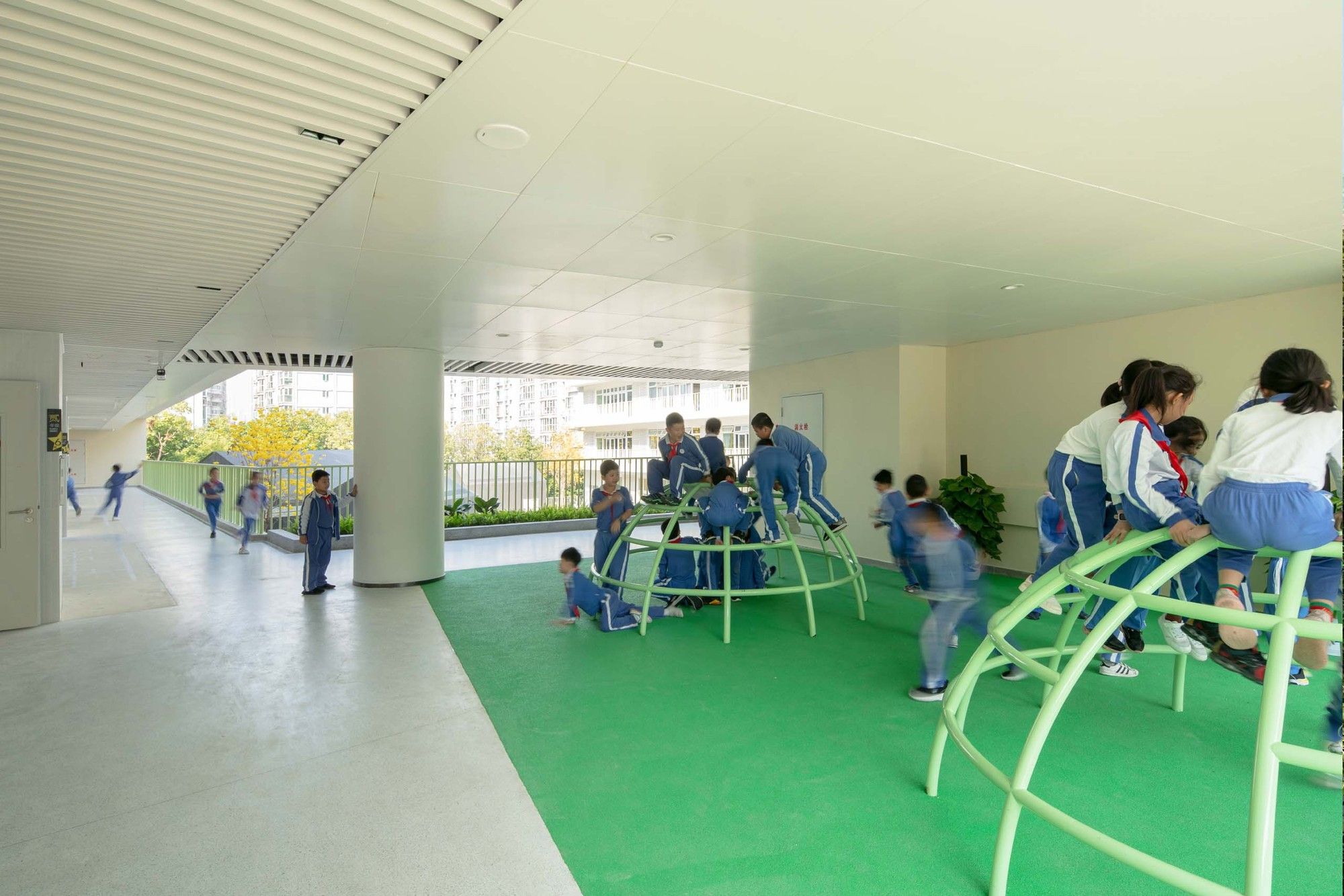
Landscape installation on the platform. Image © Chao Zhang
Our team is responsible for the architecture, landscape, and interior design of the entire campus. Making scenes of lively activities with smiles on children’s faces is one of our goals in the design process. If children engage in happy activities outside the classroom in their daily lives, their concentration and enthusiasm for classroom learning will naturally increase.
When we set this goal, the architectural design method will be adjusted accordingly: the design that can make children smile should be closer to the children’s body and experience, stimulating their exploration and imagination. Following this idea, we began to consider the size of the space suitable for children and focused on the color and texture of the material. This design method is closer to landscape design than architectural design.
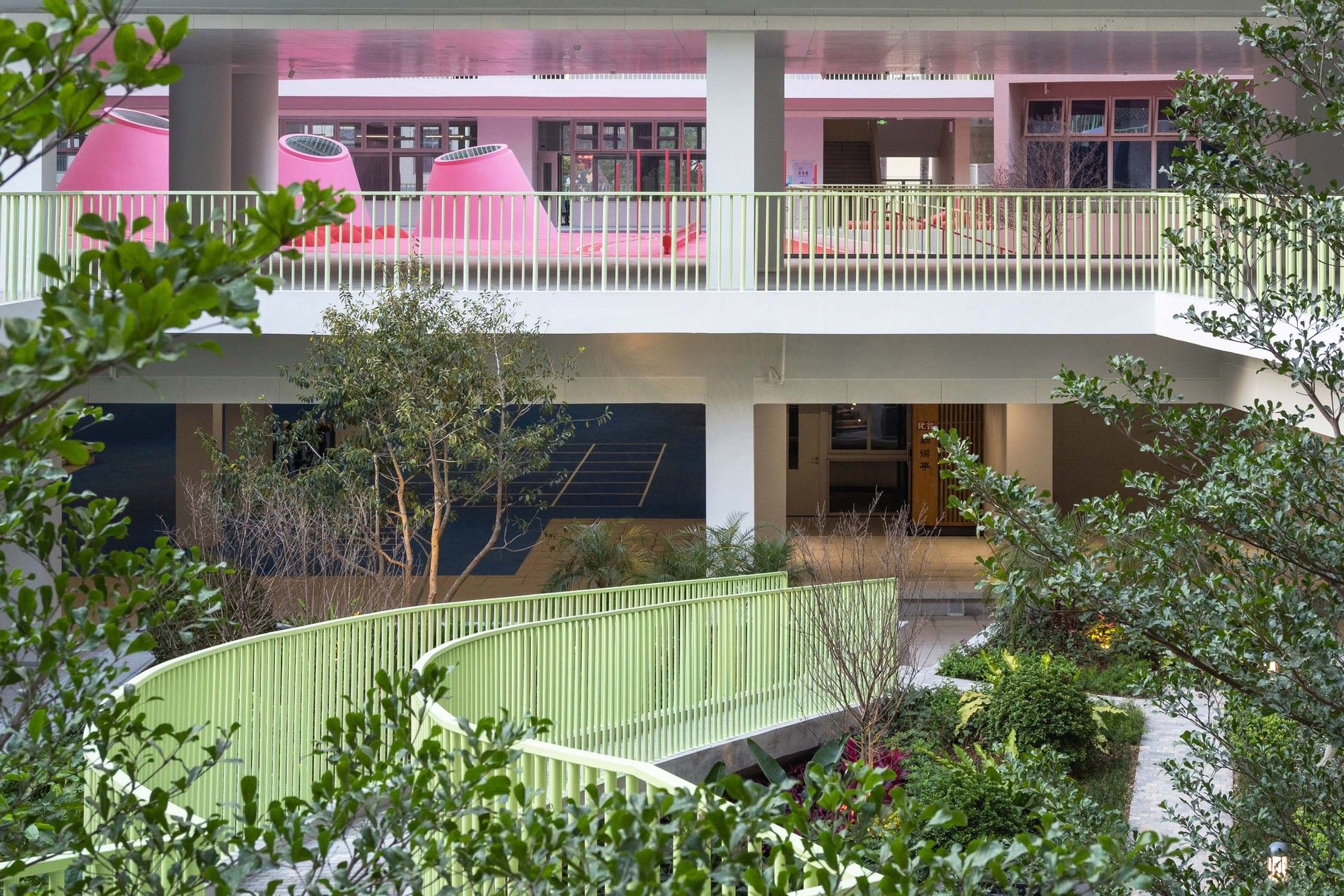
South courtyard Green forest. Image © Chao Zhang
Children are natural explorers. They like to use space freely to create original play and learn in the play. We have designed a variety of “themed playground” spaces for the school, and these themes are not obtained through commercial thematic decorations, but through the design of spatial forms. Children can freely develop related play and activities in different theme playgrounds.
On the campus of this school, there are “Green forest”, “Village alley”, “Triangular hills”, “Dome castles”, “Hill road”, “Rooftop farms”, etc. We carried out architectural design from the perspective of the landscape, making hard buildings soft, coordinating the scale of buildings and people, and creating a rich spatial experience.
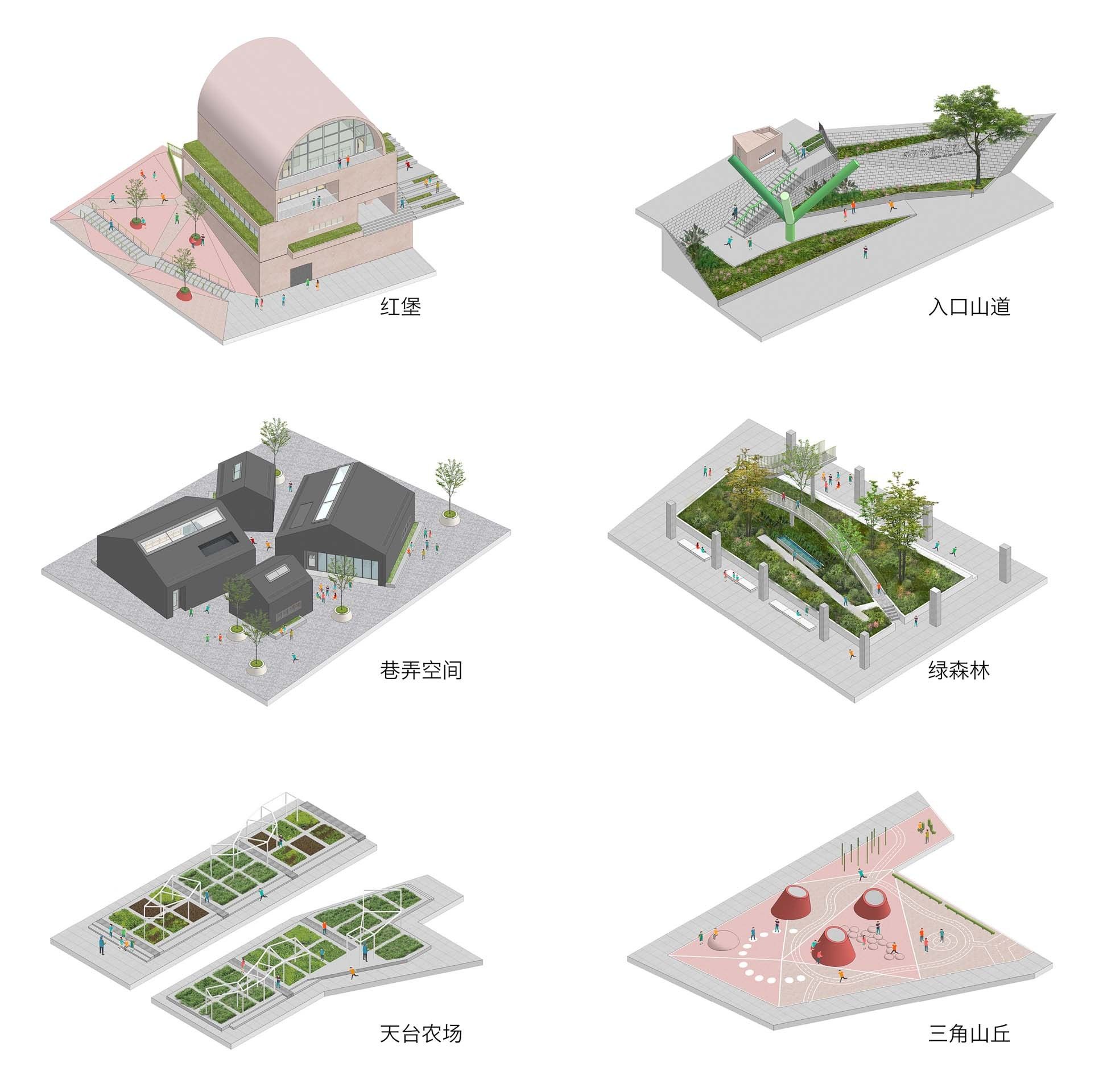
Themed playgrounds scattered throughout the campus
Because of the design of corridors and balconies surrounding the functional rooms, the teaching building appears layered slabs. According to the building regulations, the minimum height of the window sill is 90cm, and that of many new schools is often designed higher than 1.2m. It is difficult for students to look out the scenery even if they stand up.
Thanks to the external balconies, the window sill of the classroom of Xinsha Primary school is only 50cm high. The first-grade students can see outside while sitting on their seats, and the classrooms are thus opened to became an activity space on the platform. The external balconies also have the advantages of horizontal shading, allocating plants, cleaning the external windows, and maintaining the air conditioners.
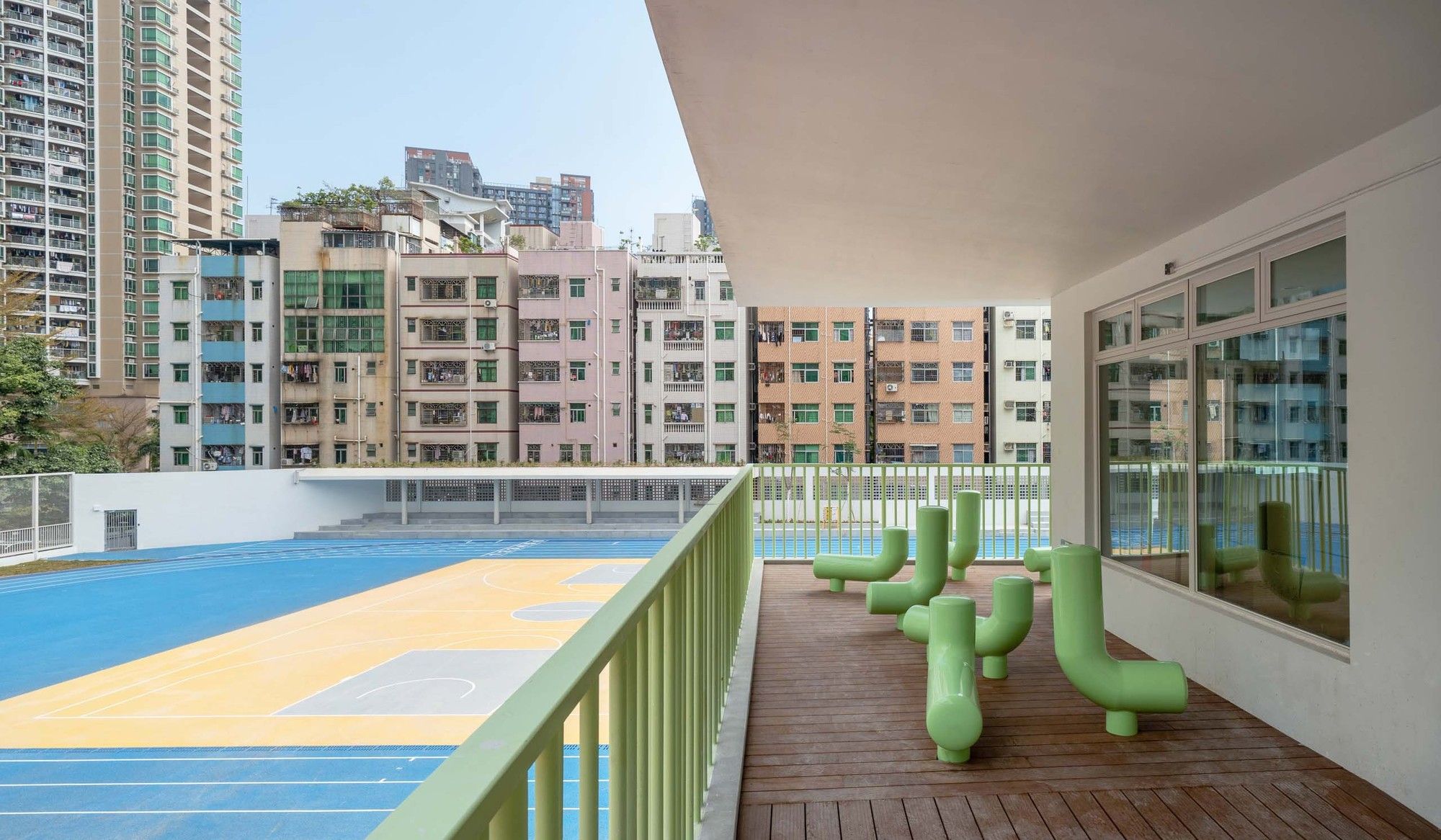
Landscape installation on the platform. Image © Chao Zhang
The guardrail of the teaching building replaced the solid balustrade wall and became an important building facade expression. We avoided using the conventional guardrail style of frame columns + thin rods and used thick and thin columns to be arranged in three-dimensional space to weaken the sense segregation and strengthen the sense of lightness. The bright green color was applied on the railings to emphasize the presence of the continuous platform.
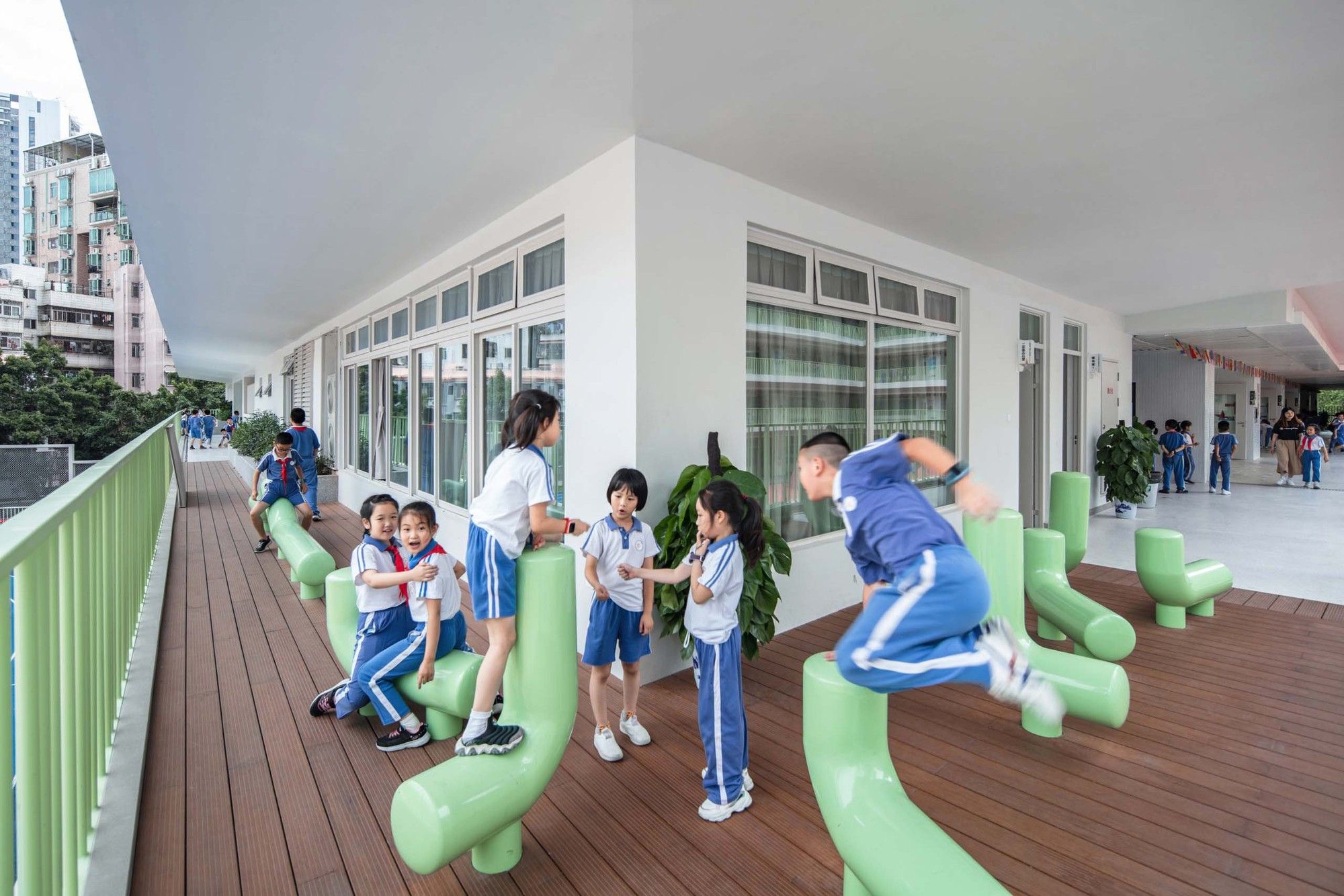
Landscape installation on the platform. Image © ACF
On the entrance steps of Xinsha Primary school, there are a few walking grass-green “little animals”, which are like handrails and sculptures, and they are not “architectural” at all. Such “little animals” hide in small public spaces on campus, waiting for students to find them and play with them. The prototype comes from the five special-shaped stools designed for the Yutian Village Community Project in Shenzhen. They play hide-and-seek in the urban jungle of the city village. On this basis, Xinsha has developed a total of 49 landscape installations of various shapes.
The design has two meanings. First, these installations can be used as landscape furniture or amusement facilities, and can also create a place for communication. When interacting with them, children use their bodies to perceive the space and create a new play together with friends; Second, these installations create a space suitable for the scale of children. From the perspective of children, the teaching building appears too large and monotonous, while landscape installations can connect large architectural spaces with small children’s bodies.
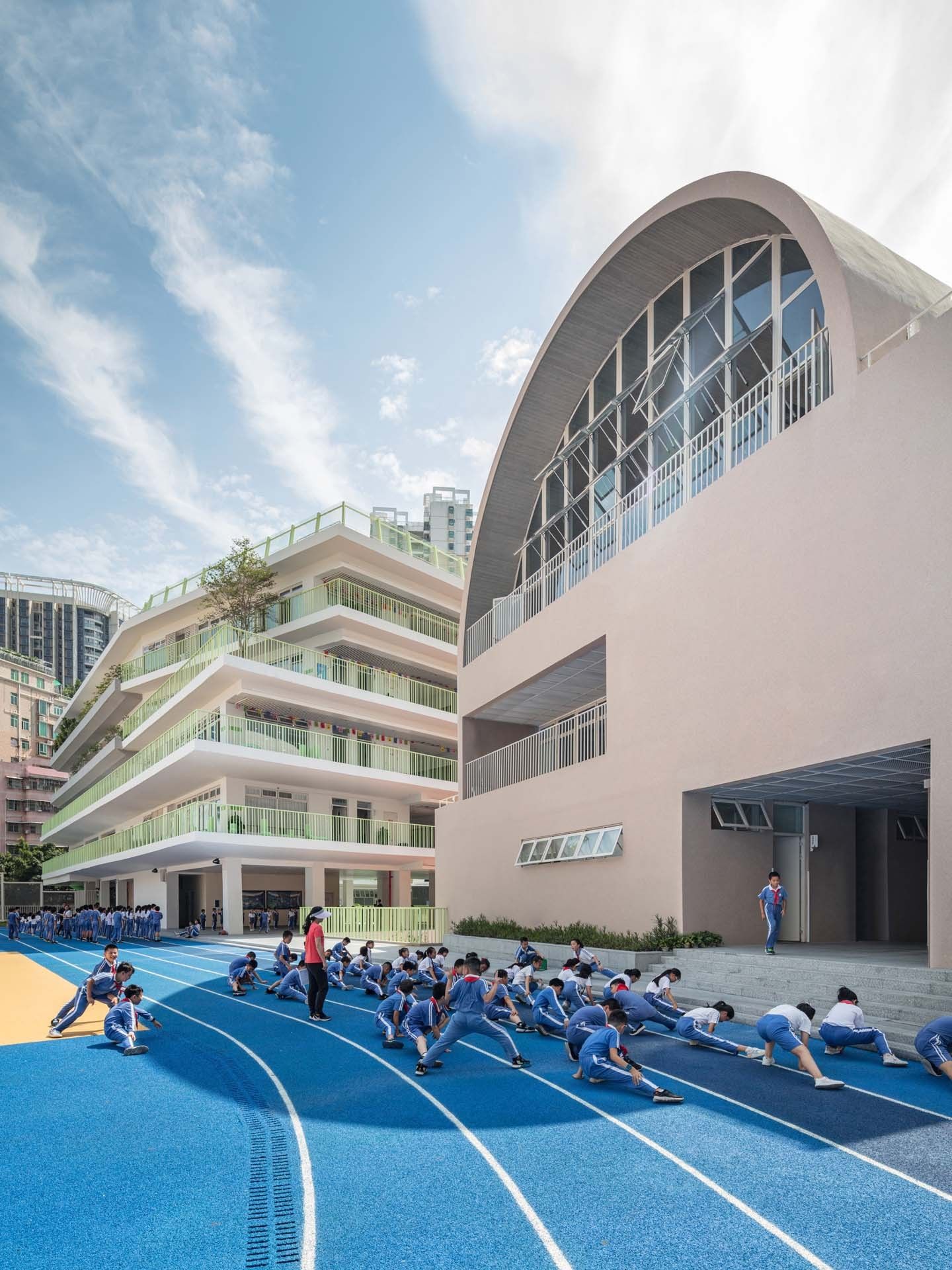
Art and cultural complex, “Dome castles”. Image © ACF
Shenzhen Tianhua is responsible for the design and submission of the construction drawings. In terms of structural design, the teaching building of Xinsha Primary School mainly adopts a frame-shear wall structure. Special structures such as large span steel beams(indoor play court and swimming pavilion), steel-concrete composite structure(4m’s cantilevered arcade), concrete-filled steel tube columns(the tree-shaped column at the entrance,) thin-shell concrete (red fortress,) is adopted to meet the needs of the various spaces. The clear space height is guaranteed by strictly controlling the beam height and some embedded pipelines through concrete beams.
BIM forward design as applied in this project. In the design stage, each discipline performs spatial integration and pipeline synthesis in the 3D model. The deliverables are 3D BIM models and 2D drawings. 3D drawings are provided for construction and used to guide on-site construction. BIM makes the collaboration of all professions more smooth and makes the communication between architects, clients, contractors, and other related parties more efficient.
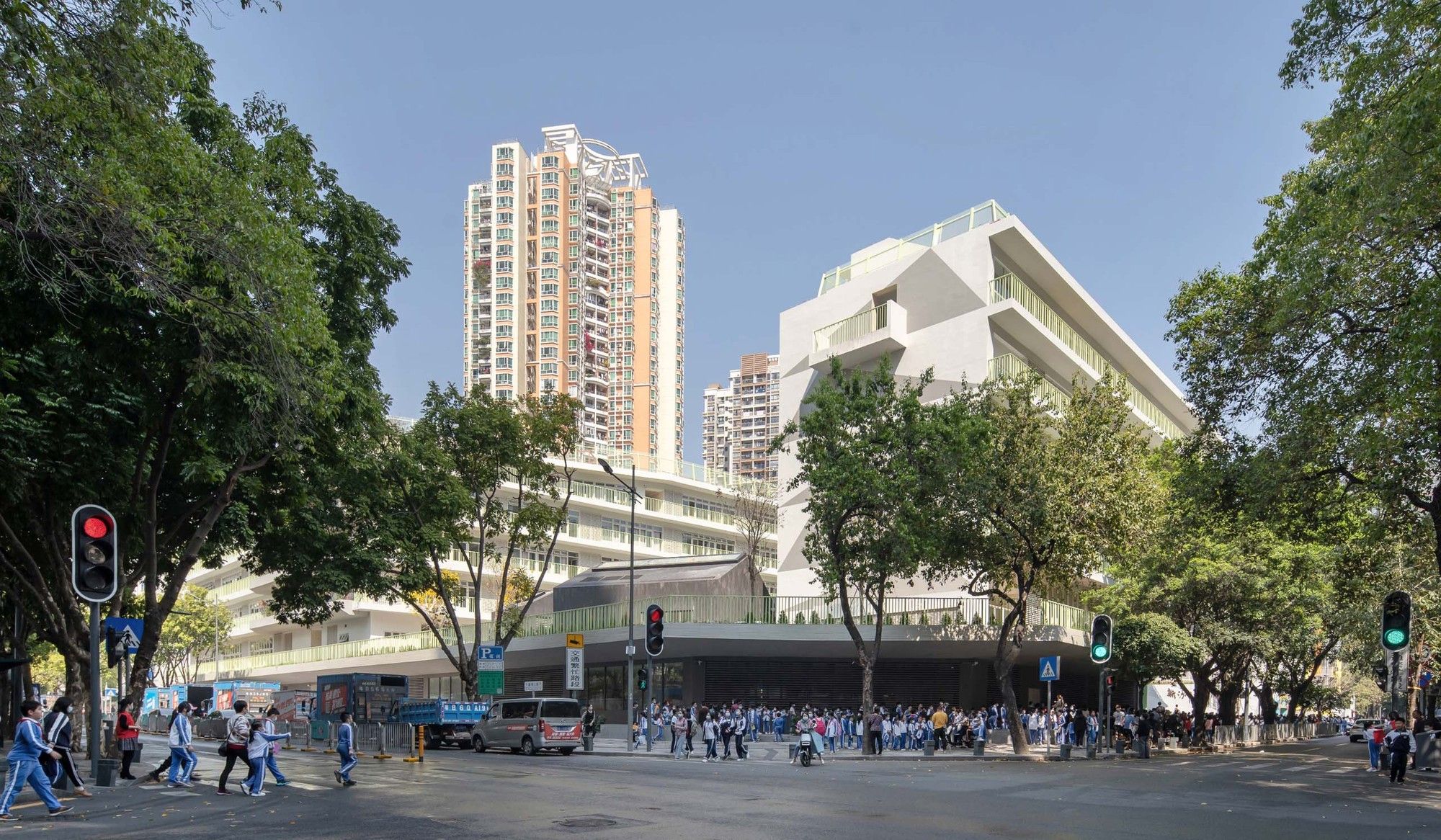
Street view from crossroads. Image © Chao Zhang
Another goal of the “8+1 New Campus Action Plan” is to explore campus design that is open to the community. The built environment of Xinsha Primary School has a clear sense of openness. In the future, the school can be further opened for community sharing with the management arrangement.
In addition to the main entrance leading to the second-floor platform, we also designed the first-floor entrance, which connected to the 6m-wide central corridor in the podium. It can directly reach the library, canteen, multi-function hall, indoor swimming pool, and gymnasium, and will not cross the teaching flow line above, which is convenient for students and the community to share this campus during holidays.
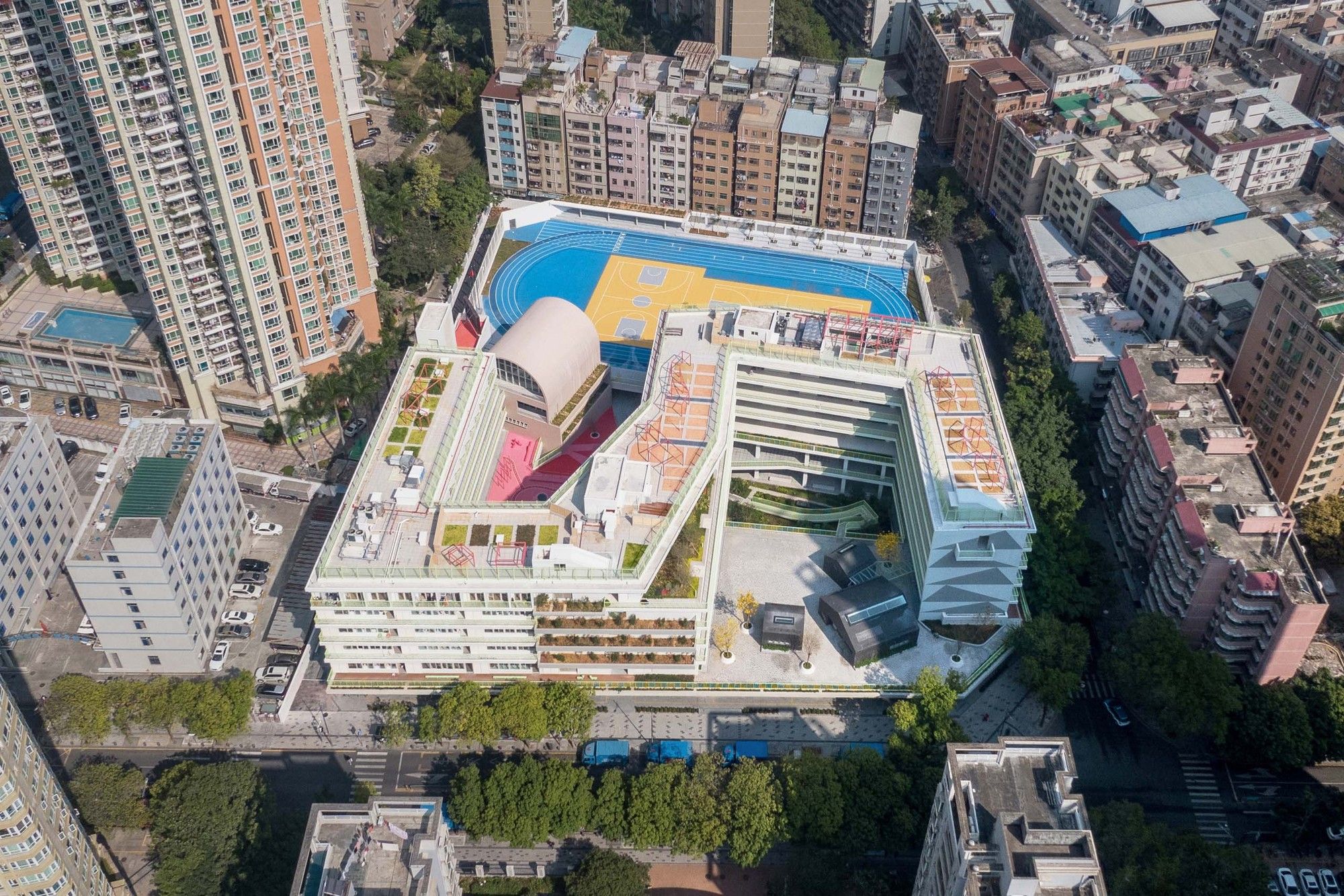
S-shaped teaching building layout. Image © Chao Zhang
Project Info:
Architects: 11ARCHITECTURE
Location: Shenzhen, China
Area: 37000 m²
Project Year: 2021
Photographs: Chao Zhang, ACF
- S-shaped teaching building layout. Image © Chao Zhang
- Street view from crossroads. Image © Chao Zhang
- View of the library in the arcade from the street. Image © Chao Zhang
- The main entrance to the campus. Image © Chao Zhang
- The public space along Xinzhou 3rd Street. Image Courtesy of 11ARCHITECTURE
- Raised campus platform. Image © Chao Zhang
- The unique shaped-column at the entrance. Image © Chao Zhang
- South courtyard Green forest. Image © Chao Zhang
- Art and cultural complex, “Dome castles”. Image © ACF
- North courtyard. Image © Chao Zhang
- North courtyard and conical skylights. Image © ACF
- Guardrail design. Image © Chao Zhang
- Triangular hills. Image © Chao Zhang
- South courtyard Green forest. Image © Chao Zhang
- Landscape installation on the platform. Image © Chao Zhang
- Landscape installation on the platform. Image © Chao Zhang
- Landscape installation on the platform. Image © ACF
- Landscape installation on the platform. Image © Chao Zhang
- Dance studio and its roof made of wooden formwork fair-faced concrete. Image © ACF
- Conical skylights below the Triangular hill. Image © Chao Zhang
- Themed playgrounds scattered throughout the campus
- Design strategy: platform building and theme playground
- site plan
- 1F plan
- 2F plan
- 3F plan
- sections


